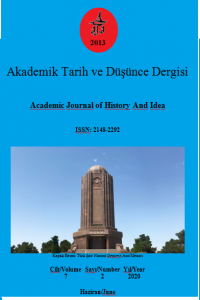Klasik Çağ Hellen Siyasi İmgeleminde Persler: Bir Kent-Devleti Tasavvuru
Hellenler, Persler, politik imge, kent-devleti
___
- ASSMAN, J., Kültürel Bellek: Eski Yüksek Kültürlerde Yazı, Hatırlama ve Politik Kimlik, (çev. Ayşe Tekin), Ayrıntı Yayınları, İstanbul 2001.
- BLACKWELL, C. W., “The Council of the Areopagus”, Dēmos: Classical Athenian Democracy, (ed. A. Mahoney–R.Scaife), The Stoa: a consortium for electronic publication in the humanities (http://www.stoa.org/demos/areopagus.pdf, online publication date: 2003)
- BROCK, R., Greek Political Imagery from Homer to Aristotle, Bloomsbury, London 2013.
- CANCIK, H., “The Awareness of Cultural Diversity in Ancient Greece and Rome”, Exploring Humanity: Intercultural Perspectives on Humanism, (ed. Mihai I. Spariosu– Jörn Rusen), National Taiwan University Press, Taiwan 2012, s. 123-145.
- COLE, S. G., “‘I Know the Number of the Sand and the Measure of the Sea’: Geography and Difference in the Early Greek”, Geography and Ethnography: Perceptions of the World in Pre‐Modern Societies, (ed. Kurt A. Raaflaub– Richard J. A. Talbert), Blackwell, New Jersey 2010, s. 197-214.
- DEWALD, C.– MARINCOLA, J., “Introduction”, The Cambridge Companion to Herodotus, (ed. Carolyn Dewald–John Marincola), Cambridge University Press, Cambridge 2006, s. 1-12.
- FGrHist = Die Fragmente der Griechischen Historiker
- FUSTEL De COULANGES, N. D., The Ancient City: A Study on the Religion, Laws and Institutions of Greece and Rome, Batoche Books, Ontario 2001.
- GRUEN, E. S., Rethinking the Other in Antiquity, Princeton University Press, Princeton 2012.
- HALL, E., Inventing the Barbarian: Greek Self-definition through Tragedy, Oxford University Press, Oxford 1989.
- HALL, E., Aeschylus: Persians, Aris&Phillips, Warminster 1996.
- HANSEN, M. H., Polis and City-State: An Ancient Concept and its Modern Equivalent, The Royal Danish Academy of Sciences and Letters, Copenhagen 1998.
- HARRIS, E. M., “Aeschylus’ Eumenides: The Role of the Areopagus, the Rule of Law and Political Discourse in Attic Tragedy”, Poet and Orator: A Symbiotic Relationship in Democratic Athens, (ed. A. Markantonatos– E. Volonaki), De Gruyter, Berlin 2019, s. 389-419.
- HARRISON, T., The Emptiness of Asia: Aeschylus’ Persians and the History of the Fifth Century, Bristol Classical Press, London 2000.
- HARTOG, F., Herodotos’un Aynası: Öteki Tasavvuru Üzerine Bir Deneme, (çev. Mehmet Emin Özcan), İthaki Yayınları, İstanbul 2014.
- HENKELMAN, W.F.M., “Cyrus the Persian and Darius the Elamite: a Case of Mistaken Identity”, Herodotus and the Persian Empire, (ed. Robert Rollinger–Brigitte Truschnegg–Reinhold Bichler), Harrassowitz Verlag, Wiesbaden 2011, s. 577-634.
- JOHNSON, D. M., “Persians As Centaurs in Xenophon’s Cyropaedia”, Transactions of the American Philological Association, C. 135, (2005), s. 177-207.
- KOIV, M., “Basileus, tyrannos and polis: The Dynamics of Monarchy in Early Greece”, Klio C. 98, S. 1 (2016), s. 1–89. LARSON, J., Ancient Greek Cults: A Guide, Routledge, New York 2007.
- PODRAZIK, M., “The Skēptouchoi of Cyrus The Younger”, Iran and Western Asia in Antiquity: New Perspectives, (ed. Marek Jan Olbrycht ), Anabasis: Studia Classica et Orientalia, C. 8, (2017), s. 16-37.
- POTTS, D. T., “Cyrus the Great and the Kingdom of Anshan”, The Idea of Iran I: Birth of the Persian Empire, (ed. Vesta Sarkhosh Curtis– Sarah Stewart), I.B.Tauris, London 2005, s. 1-27.
- PROVENCAL, V. L., Sophist Kings: Persians as Other in Herodotus, Bloomsbury, London 2015.
- ROMM, J., “Continents, Climates, and Cultures: Greek Theories of Global Structure”, Geography and Ethnography: Perceptions of the World in Pre‐Modern Societies, (ed. Kurt A. Raaflaub– Richard J. A. Talbert), Blackwell, New Jersey 2010, s. 215-235.
- TUPLIN C., “Xenophon, Sparta and the Cyropaedia”, The Shadow of Sparta, (ed. Anton Powell–Stephen Hodkinson), Routledge, London 1994, s. 127–181.
- Yayın Aralığı: Yılda 6 Sayı
- Başlangıç: 2013
- Yayıncı: Hakan YILMAZ
Osmanlı’dan Cumhuriyet’e Bir Siyasetçi Profili: Ahmet Muhtar Fikri Bey (Gücüm) (1876-1930)
Türklerde Hz. Peygamber Sevgisine Bir Örnek Olarak Süleyman Çelebi’nin “Vesîletü’n-Necât” Adlı Eseri
Frig Göçlerinin Zamanı Üzerine Bazı Öneriler
Sovyet Rus Kültür Politikası ve Türkistan Asâr-ı Atikasının Akıbeti
Ortadoğu’da Ermeni Diasporası: İran, Lübnan ve Suriye Ermenilerine Dair Tarihi Bir Değerlendirme
Amerikan Board (ABCFM) ve Fetullahçı Terör Örgütü (FETÖ)
Klasik Çağ Hellen Siyasi İmgeleminde Persler: Bir Kent-Devleti Tasavvuru
Haçlıların Düğün ve Cenaze Merasimlerine Müslümanların Bakışı
